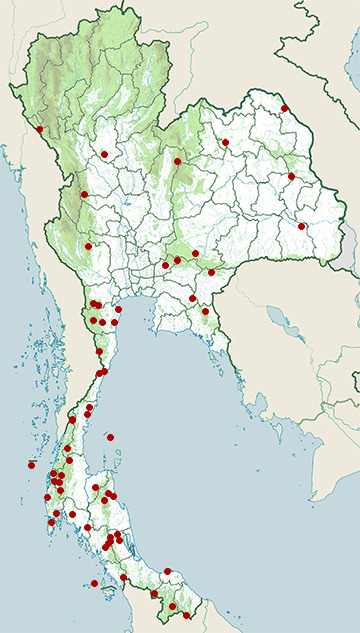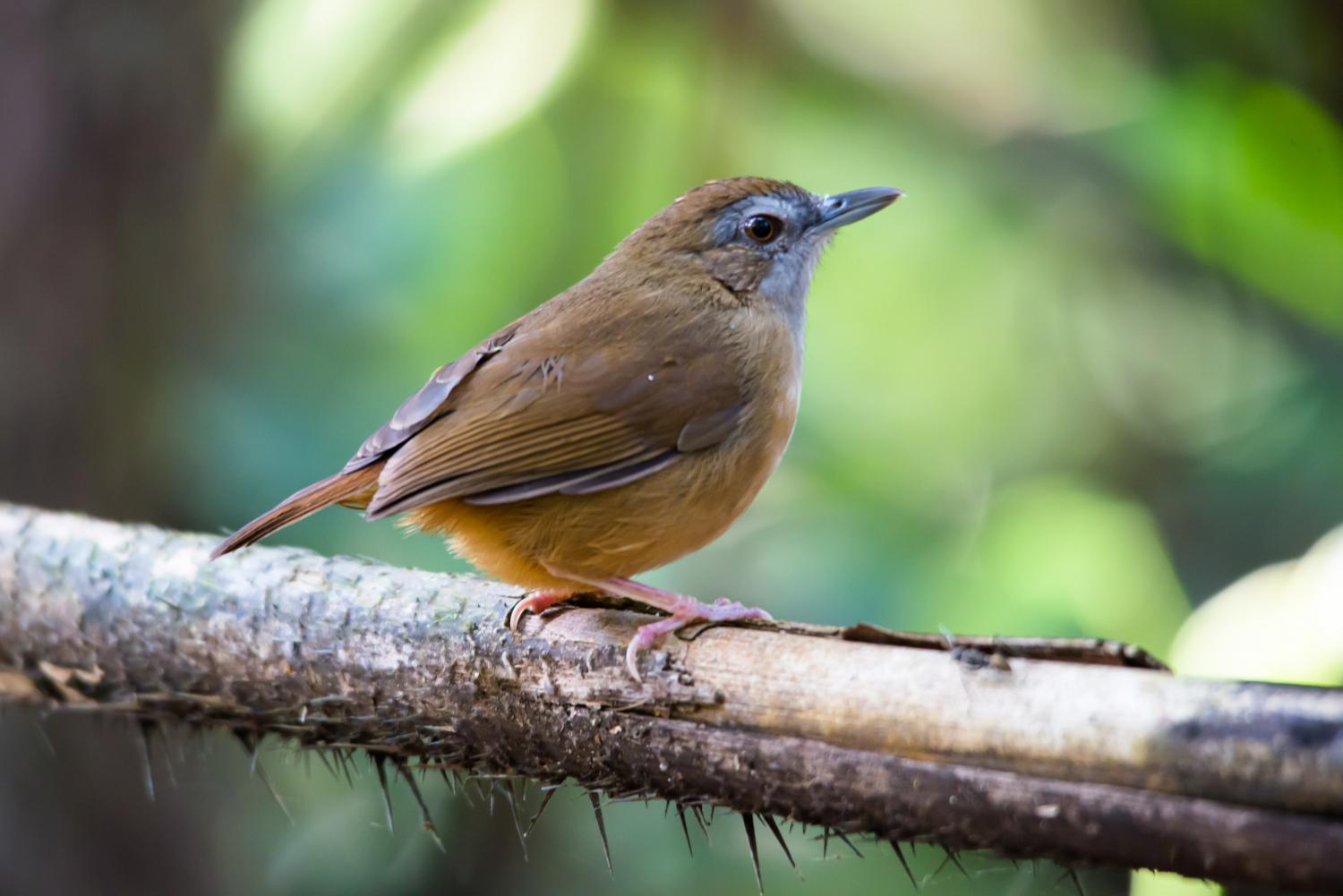Species of Thailand
Abbott's babbler
Malacocincla abbotti
Edward Blyth, 1845
In Thai: นกกินแมลงป่าฝน
Abbott's babbler (Malacocincla abbotti) is a species of bird in the family Pellorneidae. It is widely distributed along the Himalayas in South Asia and extending into the forests of Southeast Asia. They are short-tailed and stout birds which forage in pairs in dense undergrowth close to the ground and their presence is indicated by their distinctive calls.
Taxonomy
Abbott's babbler was described by the English zoologist Edward Blyth in 1845 and given the binomial name Malacocincla abbotti. The genus name Malacocincla combines the Ancient Greek malakos meaning "soft" with modern Latin cinclus, meaning "thrush"; referring to the birds' full and drooping plumage. The specific name abbotti was chosen by Blyth to honour the specimen collector, Lieutenant Colonel J. R. Abbott (1811–1888) who served in British India as Assistant Commissioner of the Arakan from 1837 to 1845. Blyth erected the new genus Malacocincla for this species but subsequent workers placed the species in Turdinus and Trichastoma. A revision reinstated its placement in Malacocincla in 1985. A 2001 study confirmed the cohesiveness of the Trichastoma group but a 2012 study shows that M. abbotti and M. sepiaria are in a clade along with Napothera while M. cinereiceps and M. malaccensis fall into a different clade along with the genus Trichastoma and several species of Pellorneum. An isolated population occurs in the Visakhapatnam Ghats, well separated from the nearest main distribution along the Himalayas and was named after Indian ornithologist K.S.R. Krishna Raju by Dillon Ripley and Bruce Beehler in 1985. The nominate population is from southern Myanmar and extends to southern Tenasserim and northwestern Malaya including the Langkawi Islands. Several other populations of this widespread species have been named as subspecies and not all are recognized. The population in the eastern Himalayas from eastern Nepal to Sikkim and Assam was named as amabile but is now considered within the nominate subspecies. Others include altera (central Laos and Annam), williamsoni (eastern Thailand and northwestern Cambodia), obscurior (coastal southeastern Thailand), olivaceum (Peninsular Thailand and Malaya), sirense (Borneo, Pulau Mata Siri) and baweanum (Bawean Island).
Eight subspecies are recognised:
- M. a. abbotti Blyth, 1845 – east Himalayas to central Malay Peninsula
- M. a. krishnarajui Ripley & Beehler, 1985 – east India
- M. a. williamsoni Deignan, 1948 – east Thailand to south Vietnam
- M. a. obscurior Deignan, 1948 – east Thailand and southwest Cambodia
- M. a. altera (Sims, 1957) – central Laos and central Vietnam
- M. a. olivacea (Strickland, 1847) – south Malay Peninsula and Sumatra
- M. a. concreta Büttikofer, 1895 – Borneo and Belitung Island
- M. a. baweana Oberholser, 1917 – Bawean Island (north of Java)
Description
The adult Abbott's babbler is a nondescript, brown, short-tailed, babbler that moves about in the low vegetation often near streams and in the vicinity of tree ferns and tangled vegetation. The throat is grey-white while the center of the belly is white and the flanks are olive. The undertail coverts are rusty-colored. The sexes are alike. It has a short tail and heavy bill; it is drab olive-brown with bright rusty lower flanks and vent, a greyish-white throat and breast and variable pale grey supercilium and lores. Juvenile birds have dark rufescent-brown crowns and upperparts. The calls are distinctive. The subspecies M. a. krishnarajui of the Eastern Ghats has a darker russet tail and rump than the Himalayan nominate subspecies. Specimens measure 12 – 13 cm in length, with a head of 39 – 44 mm and tail of 55 – 61 mm.
Distribution and habitat
In South Asia, Abbott's babbler is resident from Nepal to Arunachal Pradesh and the Assam Valley in India, south throughout the South Assam hills, including Meghalaya and south through the Lushai Hills. It is also resident in east and south Bangladesh (around Jessore and Khulna), and the Eastern Ghats in North-east Andhra Pradesh and Odisha. It occurs up to 600 m (2000 ft), 275 m (900 ft) in Nepal. It is widely distributed across Southeast Asia.
It is common across much of its large range. It is seen in the understory of broadleaved evergreen forest, forest edge, secondary growth and scrub. In Singapore, they have been noted as being tolerant to disturbance and adapting to secondary growth and disturbed forest.
Behaviour and ecology
Abbott's babbler usually moves around in pairs close to the ground. They breed from April to July (summer monsoon), with the nest being a carefully placed but bulky cup low in palms or other undergrowth. A study in Thailand found that most nests are placed in spiny palms and rattans. The usual clutch is 3 to 5 eggs which are bright salmon with dark blotches and red lines. When disturbed at the nest, the bird slip over the edge and fly with laboured wing beats and then hop out of sight. More than one brood may be raised in a season.
Their distinctive calls consists of three or four notes with the a drop on the middle note. The antiphonal duet of a male and female has the male leading with a "poor'ol bear" followed by the females "dear dear". The tunes may however change over time. The birds tend to remain within a well marked area and do not wander widely. The song is a variable short series of around three to four notes of rich, fluty, liquid, slurred, short whistled notes; these are sometimes delivered haltingly and sometimes rapidly. The evening group song consists of a recurrent sputtering churrr sound, which is low and slurred; ending with a sharp chreep. Calls include soft mewing notes, and a pulsing, purring trill when agitated.
This article uses material from Wikipedia released under the Creative Commons Attribution-Share-Alike Licence 3.0. Eventual photos shown in this page may or may not be from Wikipedia, please see the license details for photos in photo by-lines.
Category / Seasonal Status
BCST Category: Recorded in an apparently wild state within the last 50 years
BCST Seasonal status: Resident or presumed resident
Scientific classification
- Kingdom
- Animalia
- Phylum
- Chordata
- Class
- Aves
- Order
- Passeriformes
- Family
- Pellorneidae
- Genus
- Malacocincla
- Species
- Malacocincla abbotti
Common names
- Thai: นกกินแมลงป่าฝน
Subspecies
Malacocincla abbotti abbotti, Edward Blyth, 1845
Malacocincla abbotti altera, Sims, 1957
Malacocincla abbotti baweana, Harry Church Oberholser, 1917
Malacocincla abbotti concreta, Johann Büttikofer, 1895
Malacocincla abbotti krishnarajui, Sidney Dillon Ripley & Bruce M. Beehler, 1985
Malacocincla abbotti obscurior, Herbert Girton Deignan, 1948
Malacocincla abbotti olivacea, Strickland, 1847
Malacocincla abbotti williamsoni, Herbert Girton Deignan, 1948
Synonyms
- Turdinus abbotti
- Trichastoma abbotti
Conservation status

Least Concern (IUCN3.1)
Photos
Please help us review the bird photos if wrong ones are used. We can be reached via our contact us page.
Range Map

- Ao Phang-Nga National Park
- Bang Lang National Park
- Chaloem Phrakiat Thai Prachan National Park
- Chaloem Rattanakosin National Park
- Hala-Bala Wildlife Sanctuary
- Hat Wanakon National Park
- Huai Yang Waterfall National Park
- Kaeng Krachan District, Phetchaburi
- Kaeng Krachan National Park
- Kaeng Krung National Park
- Kanthararom District, Sisaket
- Khao Ang Rue Nai Wildlife Sanctuary
- Khao Banthat Wildlife Sanctuary
- Khao Chong
- Khao Dinsor (Chumphon Raptor Center)
- Khao Lak - Lam Ru National Park
- Khao Luang National Park
- Khao Nan National Park
- Khao Nang Phanthurat Forest Park
- Khao Phanom Bencha National Park
- Khao Phra - Bang Khram Wildlife Sanctuary
- Khao Phra Thaeo Wildlife Sanctuary
- Khao Pu - Khao Ya National Park
- Khao Soi Dao Wildlife Sanctuary
- Khao Sok National Park
- Khao Yai National Park
- Khlong Phanom National Park
- Khlong Saeng Wildlife Sanctuary
- Khuan Khanun District, Phatthalung
- Khura Buri District, Phang Nga
- Ko Tao
- Kromluang Chumphon Wildlife Sanctuary
- Kui Buri National Park
- Mae Moei National Park
- Mae Wong National Park
- Mueang Nakhon Nayok District, Nakhon Nayok
- Mueang Pattani District, Pattani
- Mueang Phatthalung District, Phatthalung
- Nam Nao National Park
- Pachee River Wildlife Sanctuary
- Pak Thale
- Pang Sida National Park
- Pathio District, Chumphon
- Pha Nam Yoi Forest Park
- Phato District, Chumphon
- Phu Foi Lom National Park
- Phu Langka National Park
- Ramkhamhaeng National Park
- Sakaerat Environmental Research Station
- San Kala Khiri National Park
- Sri Phang Nga National Park
- Surin Islands
- Tai Rom Yen National Park
- Tarutao National Marine Park
- Tha Sala District, Nakhon Si Thammarat
- Thale Ban National Park
- Wang Mai Forest Restoration Project
- Yan Ta Khao District, Trang

